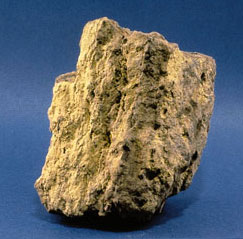We often fret about manmade toxins. Since the turn of the twentieth century, about 80,000 new chemicals have been introduced into our environment. Yet there are many naturally occurring toxins that have been around for millennia, as Dr. Gary Ginsberg and Brian Toal of Connecticut note in their book What’s Toxic, What’s Not. Radon is a naturally occurring radioactive gas. It lands on Ginsberg and Toals’ top ten list of toxic risks, along with particulate and ozone air pollution, lead paint, carbon monoxide, dioxin and mercury in food, arsenic at home, heating with wood, and volatile chemicals.
 |
Uranium Ore, Wikimedia Commons photo. Radon gas comes from minerals in the soil that have uranium in them. Uranium is seldom evenly distributed throughout rocks and soils. Production and movement of radon gas can vary, depending on a variety of factors, including the types of minerals, fractures and faults in the rocks, soil types, and water and air spaces in the soil. |
Few people had even heard of radon before 1984. It got national attention when Stanley Watras, an engineer working at a nuclear power plant in Pennsylvania, kept setting off radiation alarms on his way into the plant. When the source of contamination could not be identified at work, he persuaded health physicists to test his house. They found levels of radon that were about 650 times higher than what was considered safe. (New York Times, 1987.)
Geologists figured out that the radon was coming from a geological foundation beneath Watras’ house. The formation is called the Reading Prong. It extends through eastern Pennsylvania, northern New Jersey and parts of New York. The Reading Prong is loaded with naturally occurring uranium.
Over time, uranium in the earth breaks down and forms a gas. The radon gas moves upward through the soil. It can enter a house through cracks or utility openings in the foundation or sump pits. It can then be trapped inside the structure, where it can build up. The Watras incident spurred a nationwide radon testing program. What they found is that radon is an invisible guest in many homes.
Radon does not announce its presence in any form that our senses can identify. You cannot see it, smell it or taste it. Short-term exposure to radon has no visible effects on health. It does not cause asthma, colds or bronchitis. The effects of exposure typically do not show up for decades. However, when they finally do, the results can be deadly. Radon is considered the second leading cause of lung cancer in America. In 2005, 159,217 people died of lung cancer in the U.S. (National Cancer Institute.) Smoking causes eighty to ninety percent of all lung cancers. Radon claims an estimated 20,000 to 30,000 human lives annually (National Research Council, 1999.) Smoking and radon are a bad combination. In houses with smokers, radon can latch onto particles and then get pulled into lungs, increasing the risk.
An estimated five percent of homes have radon levels that are considered unsafe. You can see EPA maps of radon zones in the U.S. at www.epa.gov/radon/zonemap.html. Windham County is labeled as Zone 2, which means it has “moderate potential for radon.” Levels in this region typically fall in ranges that are considered safe.
However, radon levels may be higher in hilly, rocky areas. They can be lower in river valleys, but there are many exceptions. Houses right next to each other can have very different levels. Any home may have a radon problem. It does not matter if it is an old home, a new home, well sealed or drafty, or whether it has a basement or not. Newer, air-tight homes prevent air leaks, so much of the replacement air comes from soil gas. With less air exchange, radon levels may be more likely to build up.
The good news is that there are several easy and inexpensive ways to test your home for radon. Next week’s article will go over testing options.
For more information about radon in CT, contact the CT Dept. of Health at (860) 509-7367 or see their website at http://tinyurl.com/lms6bd
Pam Salois is an Independent, Authorized Green Irene Eco-Consultant. See her website at
www.greenirene.com/PamWindhamCT. Bet Zimmerman is a Certified Environmental Professional. Archived Our Better Nature articles are at www.ourbetternature.org
References and More Information:
|

